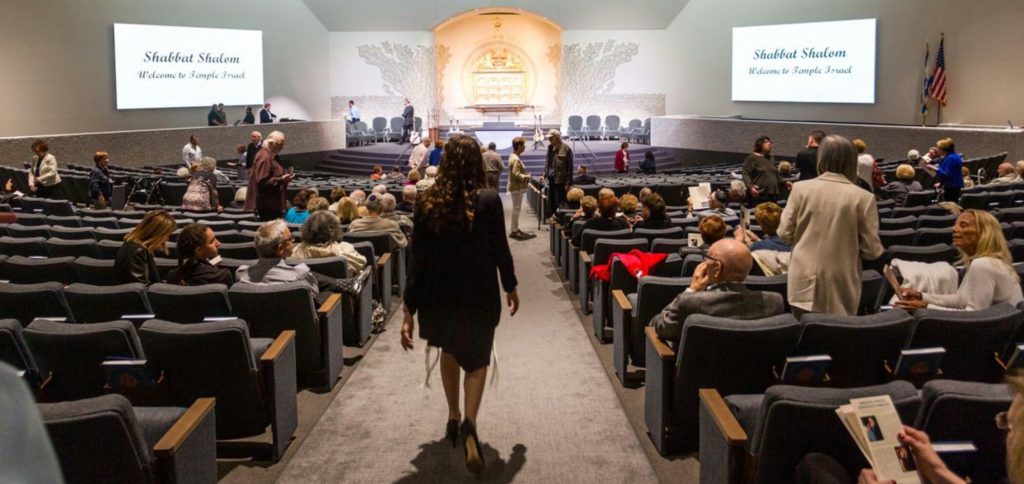From the Wall Street Journal
Temple Israel, a reform synagogue in suburban Detroit, undertook a substantial renovation a few years ago. The makeover included a spruced-up atrium and social hall, new display cases, and the installation of two video screens flanking the pulpit.
The screens made their debut in 2017 during Rosh Hashana services with a slideshow designed to underscore the theme of Rabbi Jen Lader’s sermon. The medium-is-the-message topic: the role of technology in enhancing communal experiences. “It felt risky to use the screens as the foundation of a High Holiday service,” Rabbi Lader said. “But the feedback was overwhelmingly positive, with people saying they understood things in a completely different way.”
Five years ago the attitude about screens from Temple Israel leadership was “absolutely not,” said Rabbi Lader, who has also used audio clips during her sermons, in one instance a recording by the violinist Joshua Bell. “But I think our world has changed so much in that time. We needed to speak in a relevant way to people who were used to consuming information in a variety of contexts, and we felt strongly that the screens would only enrich their experience here.”
Technology is now as much a part of worship as prayer books and hymnals. Congregations routinely live-stream and archive their services, and some churches even invite worshipers to text questions to pastors while they preach.
In a 2015 survey of congregations by Faith Communities Today, a research coalition, 53% of respondents said that visual projections were often or always part of their weekend worship service; in 2005 the figure was 38%.
“Every congregation is dealing with the fact that the Word is not as strong by itself as it used to be,” said Cláudio Carvalhaes, an associate professor of worship at New York’s Union Theological Seminary. “And so they feel they have to bring in something else to give force to the sermon.”
The push to add something extra to the mix is born of a fear of seeming stodgy, of missing the boat with millennials, of not keeping up with the Joneses—that is, the megachurches. “It’s, ‘Look at this cool congregation with the enormous screen, and then look at us,’ ” Mr. Carvalhaes said.
Jessica Tezen, a guest pastor at several congregations in New York City, recently used audio clips of Kanye West’s “Ultralight Beam” and Chance the Rapper’s “Blessings” in a sermon that braided the themes of social justice and the importance of taking note of the good things in life. Meanwhile, Michael Piazza, the senior pastor at the Broadway United Church of Christ, also in New York, uses a large flat-screen TV to project photographs of the iconic figures he quotes during sermons, Maya Angelou, Martin Luther King Jr. and Elie Wiesel, among them.
“I’ll use audio and video,” Mr. Piazza said. “But usually, they’re short clips. I don’t want people to think they’re coming to see a movie.” Ms. Tezen has sensed some hesitancy from older clergymen and older congregants who are used to doing things, and seeing things done, in a particular way. “What has helped,” she said, “is explaining my intention instead of assuming that everyone will understand where I’m coming from.”
Not everyone is sold. Daniel Nevins doesn’t “want to be watching Beyoncé” in a synagogue on the Sabbath. “We get that 24/6,” said Rabbi Nevins, dean of the Rabbinical School at the Jewish Theological Seminary, the center for Conservative Judaism. “We don’t use technology aside from microphones in our worship and there’s a spiritual reason. We’re trying to create an environment that is different from the mass culture that is out there, that is not distracted by glowing screens.
“We’re not antitechnology,” Rabbi Nevins continued, pointing to a communication course in the seminary’s curriculum that teaches students how to harness the internet. “But the worship space is not a multimedia experience.”
Perhaps it’s only a question of perspective. “I point to stained-glass windows,” said Scott Thumma, a sociologist and the director of the Hartford Institute for Religion Research at Hartford Seminary in Connecticut. “If you go back 500 or 1,000 years, they would have been seen as distracting. They were colorful and something you looked at while the preacher droned on and on. . . . A video is no less holy than a stained-glass window. It’s a different expression of spirituality based on your cultural mission.”
The addition of video and audio is not a cure-all for empty pews and unengaged worshipers. “There is a way in which media has been sold as a way to solve a congregation’s problem of not growing,” said Mr. Carvalhaes of Union Theological Seminary. “But the things that work best are things that grow organically, not because we want to seem trendy but because we are ministering to our people. . . . We’re all trying to do something that will make us more relevant. We’re all trying to find where the sacred is located.”
